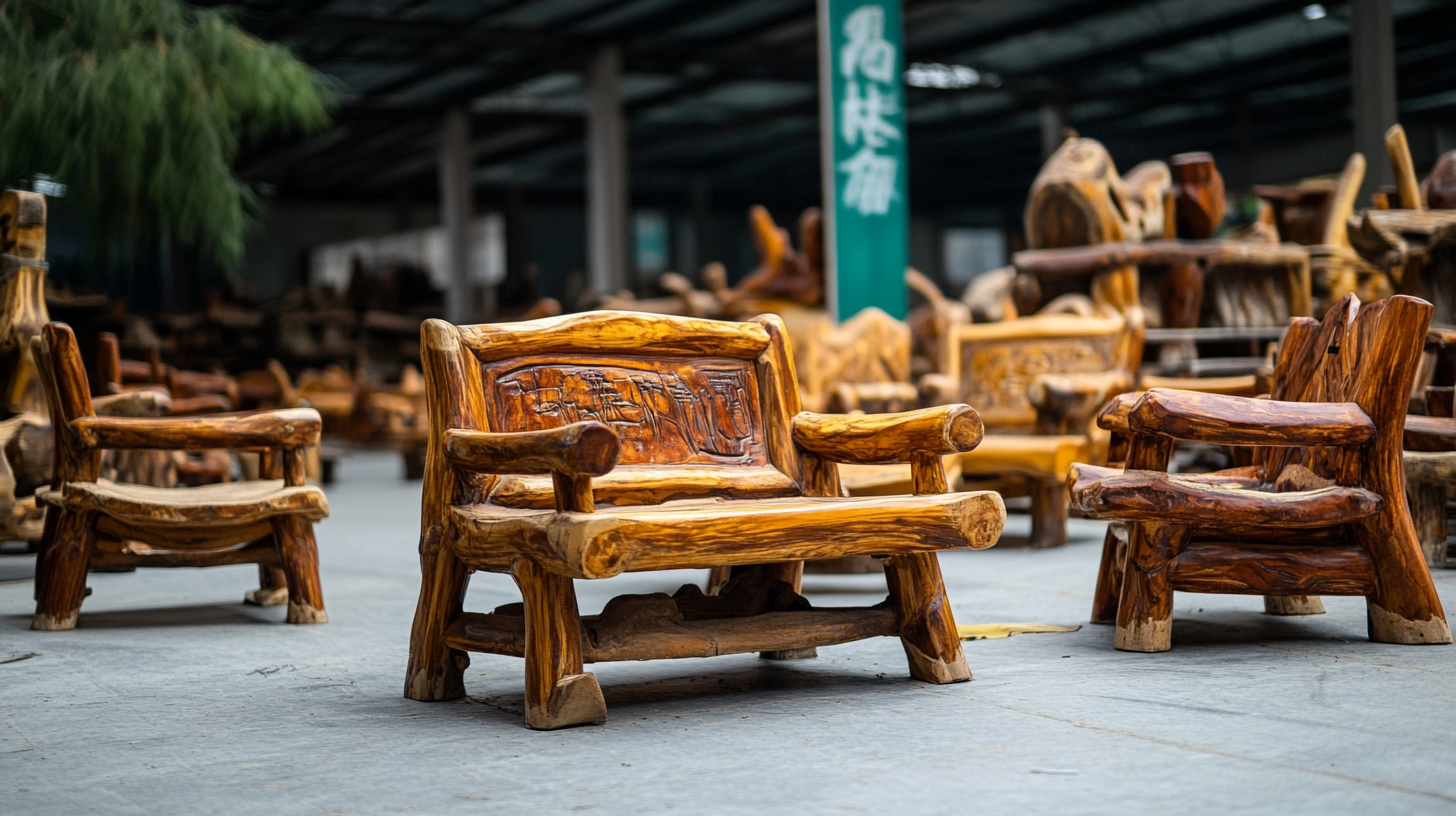China's Resilient Growth in Wooden Garden Furniture Amidst US China Tariff Challenges
In recent years, the wooden garden furniture sector has experienced a remarkable resilience, particularly in China, despite the ongoing challenges posed by US-China tariff disputes. According to a report by ResearchAndMarkets, the global wooden garden furniture market is projected to reach approximately $6 billion by 2025, reflecting a compound annual growth rate of around 5%. China's strategic investments in manufacturing and innovation have enabled it to maintain a competitive edge, allowing manufacturers to adapt to the evolving market demands while mitigating the impact of tariffs. While tariffs have increased costs for many exporters, Chinese producers have leveraged their strong supply chains and extensive experience in craftsmanship to not only sustain but also grow their market share. This blog will explore the factors contributing to the resilience of China's wooden garden furniture industry and how it continues to thrive in the face of adversity.

Resilience of China's Wooden Furniture Industry Amid Tariff Pressures
China's wooden furniture industry showcases remarkable resilience in the face of tariff pressures from the U.S. According to recent reports from the China National Forest Products Industry Association, the export value of wooden furniture reached approximately $9 billion in 2022, indicating a robust demand even amidst challenging market dynamics. The ability of Chinese manufacturers to adapt to changing trade policies demonstrates not only their operational flexibility but also their commitment to innovation and quality.
Furthermore, China’s wooden garden furniture segment has seen a significant shift towards sustainable practices, with 70% of production now utilizing eco-friendly materials. This commitment to sustainability aligns with global consumer trends, as a report by Statista indicates that nearly 60% of consumers are willing to pay more for environmentally responsible products. Manufacturers have also diversified their supply chains and explored new markets in Europe and Asia, thereby mitigating the adverse effects of U.S. tariffs. This strategic approach not only cements China's position as a leader in the wooden furniture sector but also highlights the industry's capacity to thrive under pressure.
China's Resilient Growth in Wooden Garden Furniture
Key Strategies Employed by Chinese Manufacturers to Thrive
Chinese manufacturers of wooden garden furniture have demonstrated remarkable resilience in navigating the complexities introduced by the US-China tariff landscape. According to a 2023 report by ResearchAndMarkets, the global wooden furniture market is projected to grow at a CAGR of 4.7% through 2025, with a specific surge in demand for sustainable and eco-friendly products. In response to this growing trend, Chinese manufacturers have strategically pivoted towards sustainable sourcing, focusing on certified wood and environmentally friendly production processes to appeal to a conscious consumer base.
Moreover, leveraging advanced manufacturing techniques has allowed Chinese producers to enhance efficiency and reduce costs. A joint study by the China National Forest Products Industry Association and the Wood Products Research Institute highlights that integrating automation and smart technology in production processes has resulted in a 20% increase in output while minimizing waste. Additionally, these manufacturers have been keen on diversifying their export markets beyond the United States, tapping into emerging markets in Europe and Asia, which has mitigated the impact of tariffs and expanded their global footprint.

Market Trends: Shifting Demand for Eco-Friendly Garden Furniture
The outdoor furniture market is witnessing a significant shift towards eco-friendly alternatives, driven by an increasing consumer awareness of sustainability. This trend is particularly evident in the garden furniture segment, where wooden designs are gaining popularity. As consumers become more environmentally conscious, they are actively seeking products that minimize their carbon footprint and utilize sustainable materials. This growing demand for eco-friendly garden furniture is reshaping industry dynamics and pushing manufacturers to innovate while adhering to environmentally responsible practices.
The outdoor furniture market is projected to experience substantial growth from $56.00 billion in 2025 to an impressive $81.44 billion by 2032, reflecting a compound annual growth rate (CAGR) of 5.50%. This expansion highlights a robust consumer inclination towards outdoor spaces that are not only functional but also aesthetically pleasing and sustainable. As manufacturers adapt to these market changes, they are increasingly focusing on creating durable and stylish outdoor pieces that cater to the environmentally conscious consumer, solidifying the trend of resilience amid regulatory and economic challenges.
China's Resilient Growth in Wooden Garden Furniture Amidst US China Tariff Challenges - Market Trends: Shifting Demand for Eco-Friendly Garden Furniture
| Year |
Market Size (in billion USD) |
Export Growth Rate (%) |
Eco-Friendly Market Share (%) |
Average Price (USD) |
| 2020 |
3.5 |
-2.5 |
15 |
150 |
| 2021 |
3.8 |
5.0 |
20 |
160 |
| 2022 |
4.2 |
10.5 |
25 |
165 |
| 2023 |
4.5 |
8.0 |
30 |
170 |
The Role of Innovation in Strengthening China's Export Competitiveness
Amidst the challenges posed by US-China tariffs, China's wooden garden furniture industry continues to thrive, largely due to its commitment to innovation. A report by QYResearch indicates that the global outdoor furniture market is projected to grow at a CAGR of 4.8% from 2021 to 2026, with China capturing a significant share. This growth is driven by a combination of rising consumer preferences for sustainable, high-quality products and the ongoing shift towards outdoor leisure activities, especially post-pandemic.
Innovation plays a pivotal role in enhancing export competitiveness for Chinese manufacturers. Companies are increasingly adopting advanced manufacturing techniques and eco-friendly materials, which not only comply with international standards but also meet the growing demand for sustainable products. According to a study by IBISWorld, Chinese garden furniture exports reached a staggering $1.8 billion in 2022, showcasing the effectiveness of these innovative strategies in helping manufacturers navigate tariff-related obstacles and maintain profitability in a competitive global marketplace.
China's Wooden Garden Furniture Exports (2018-2023)
This chart illustrates the growth in China's wooden garden furniture exports from 2018 to 2023, showcasing the impact of innovation and resilience amidst tariff challenges.
Impact of Tariffs on US-China Trade Relations and Future Outlook
The ongoing challenges posed by tariffs in US-China trade relations have significantly influenced the dynamics of the wooden garden furniture sector in China. A recent report highlighted that despite the 25% tariffs on Chinese imports, the Chinese wooden furniture market has demonstrated a remarkable resilience, with a growth rate of 6.3% year-on-year, largely attributed to a diversification of export markets beyond the US. This shift is crucial as brands increasingly focus on Europe and emerging markets, which have become more receptive to Chinese products, thereby mitigating the negative impacts of the tariffs.
Moreover, the recent 90-day tariff deal between the US and China has created a more optimistic outlook for commerce, with studies indicating a potential increase in trade volumes by over 20% during the agreement period. However, the future remains uncertain as political tensions linger; President Trump has accused China of violating the terms of prior agreements, which adds a layer of complexity to ongoing negotiations. Should collaborative discussions continue to falter, it could risk destabilizing the resilient growth that the wooden garden furniture industry has achieved amidst these tariff challenges.


Home
About Us
Products
Engineering Case
Buyer Service
News
Blog
Contact Us




